VMware vSphere 6.5 is scheduled to reach end of general support 15 October 2022, referenced in the VMware Lifecycle Matrix. See also How to Install vSphere 7.0. Upgrade to vSphere 7 can be achieved directly from vSphere 6.5.0 and above, whereas vSphere 6.0 requires an intermediate upgrade to 6.5 or 6.7 first. For more information see the VMware Upgrade Matrix. Finally, the Windows vCenter Server is now depreciated and not available with vSphere 7.0.
VMware vCenter Server pools ESXi host resources to provide a rich feature set delivering high availability and fault tolerance to virtual machines. The vCenter Server is a centralised management application and can be deployed as a virtual appliance or Windows machine. This post gives a walk through on a clean installation of vCenter Server 6.5 on Windows Server 2016. vCenter 6.5: Download | Release Notes | What’s New | Upgrading to vCenter Server 6.5 Update 1.
Software Considerations
- The operating system should be 64 bit and Windows Server 2008 SP2 or above.
- For environments with up to 20 hosts and 200 VMs the bundled internal Postgres database can be used.
- An external database should be Microsoft SQL Server 2008 R2 SP2 or above, or Oracle 11g or 12c. You can review a full list of compatible versions at the Database Interoperability Matrix.
- You must check compatibility of any third party products and plugins that might be used for backups, anti-virus, monitoring, etc. as these may need upgrading for vSphere 6.5 compatibility.
- Any hosts you plan on connecting to vCenter 6.5 should be running version 5.5 or above.
- To check version compatibility with other VMware products see the Product Interoperability Matrix.
Architectural Considerations
- From vSphere 6 onwards the Platform Services Controller (PSC) was introduced to the vSphere architecture. The PSC contains infrastructure services such as Single Sign On, Certificate Authority, licensing, etc. The PSC is deployed internally with vCenter Server or as an external component.
- You can read more about the PSC in this kb.
- When implementing a new vSphere 6.5 environment you should plan your topology in accordance with the VMware vCenter Server and PSC Deployment Types. Larger environments may require an external PSC.
- For more information on deploying an external PSC see the Deploying an External PSC post.
- Most deployments will include the vCenter Server and PSC in one appliance, following the embedded deployment model, which I will use in this guide.

Hardware Considerations
- Windows vCenter Server with embedded PSC requires the following hardware resources:
- Tiny (up to 10 hosts, 100 VMs) – 2 CPUs, 10 GB RAM.
- Small (up to 100 hosts, 1000 VMs) – 4 CPUs, 16 GB RAM.
- Medium (up to 400 hosts, 4000 VMs) – 8 CPUs, 24 GB RAM.
- Large (up to 1000 hosts, 10,000 VMs) – 16 CPUs, 32 GB RAM.
- X-Large (up to 2000 hosts, 35,000 VMs) – 24 CPUs, 48 GB RAM – new to v6.5.
- Where the PSC is deployed on a separate machine this requires 2 CPUs, 4 GB RAM.
- Environments with ESXi host(s) with more than 512 LUNs and 2048 paths should be sized large or x-large.
- The Windows vCenter Server requires the following free disk space for installation: (the first 2 may not necessarily be the system drive depending on installation location) Program Files 6 GB, Program Data 8 GB, System folder 3 GB. The PSC machine requires; Program Files 1 GB, Program Data 2 GB, System folder 1 GB.
- A Windows based vCenter Server can be installed on either a physical or virtual machine.
Other Considerations
- It may be necessary to temporarily stop any third party software which could interfere with the installer, such as anti-virus scanner (see post vCenter 6 Upgrade Internal Error).
- If the vCenter Server services are running as a user other than the Local System account then the user must be a member of the administrators group and have the following permissions; log on as a service, act as part of the operating system (if a domain user).
- The account used for external database authentication requires Oracle DBA role, or SQL sysadmin server role, or db_owner fixed database role. For a full list of explicit DB permissions see the Database Permission Requirements document.
- All vSphere components should be configured to use an NTP server.
- FQDN resolution should be in place when deploying vCenter Server.
- Review the list of Required Ports for vCenter Server and PSC.
- Official resources – vSphere 6.5 Documentation Centre, vSphere 6.5 Release Notes.
- Read the Important information before upgrading to vSphere 6.5 KB.
Create Data Source
Before beginning if you intend to use vCenter Server with an external SQL database be sure to install the SQL Server Native Client v10 or v11.
You must also configure a 64-bit ODBC data source for external databases. ODBC Data Source Administrator can be accessed via Control Panel > Administrative Tools. Click System DNS, Add and input the details for the external database, test the data source before continuing. If you are using the internal Postgres database then the System DSN is added automatically during installation.

Installation
Download the VMware vCenter Server and Modules for Windows ISO from VMware downloads: v6.5.0 | v6.5.0 U1.
Mount the ISO and right click autorun.exe, select Run as administrator. The VMware vCenter Installer will open. Ensure vCenter Server for Windows is selected and click Install.
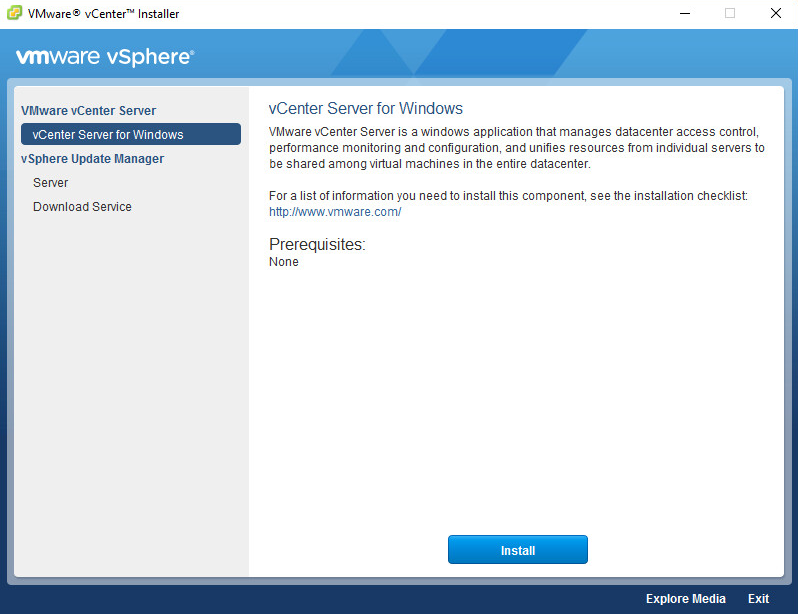
The vCenter Server 6.5 Installer will open in a separate window, click Next.

Accept the end user license agreement and click Next.

In this guide we will be using an embedded deployment model. If you are using an external deployment model the PSC component must be installed first before the vCenter. Select the deployment type and click Next. If the Windows server does not have sufficient resources allocated the installer will error at this stage.
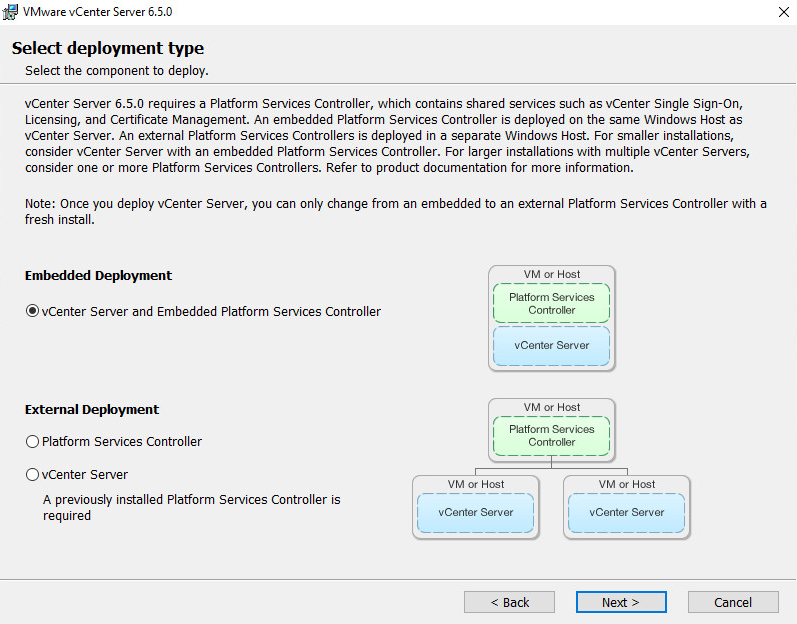
Enter the FQDN in the System Name field and click Next.
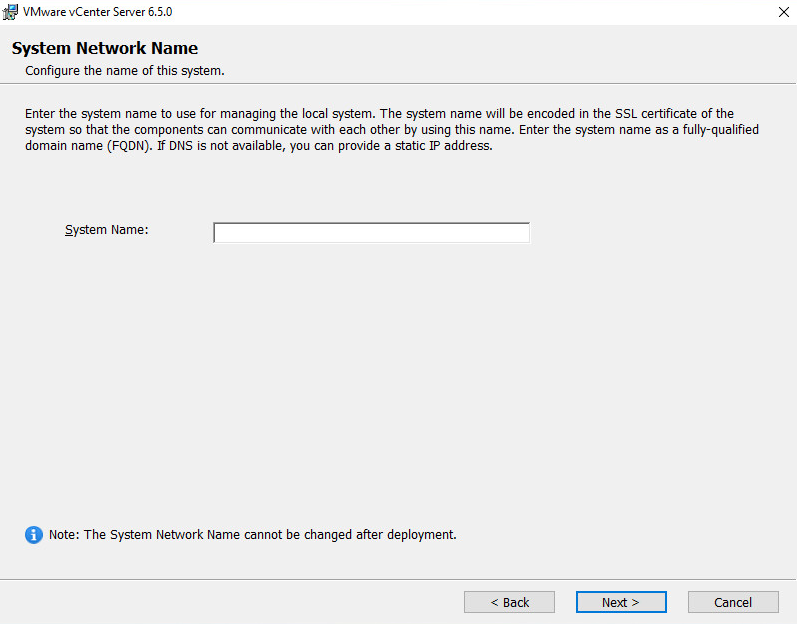
Create a new Single Sign-On domain, or join the vCenter to an existing SSO domain. If you are creating a new SSO domain give this a meaningful name, (not the same as your Active Directory name) the default is vsphere.local. Configure a password for the SSO administrator account and a vCenter specific site name, click Next.
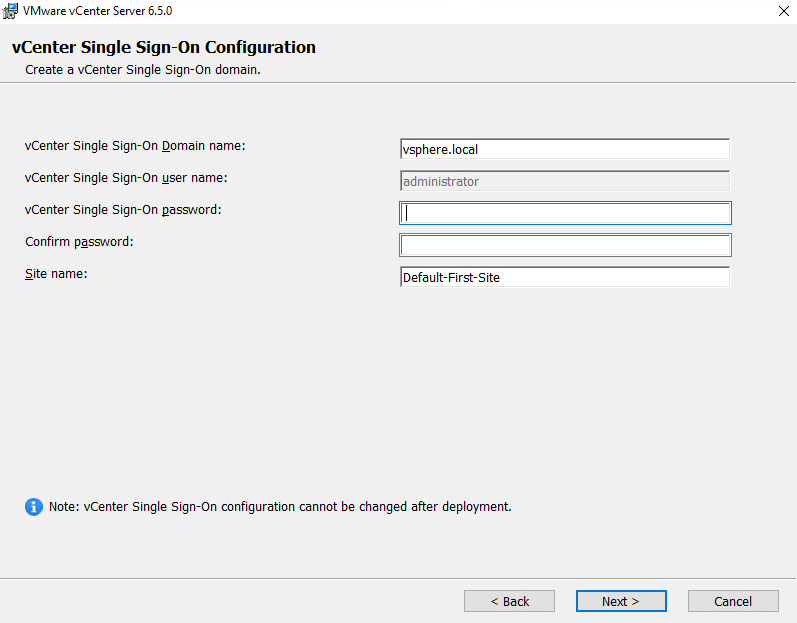
Select whether to run vCenter services as the local system account or enter details of a service account and click Next. Ensure the account running vCenter services has been granted permissions as per the other considerations section of this guide.

Select an embedded Postgre database or point the installer to the DSN for an external database, click Next.

Accept the default port configuration and click Next.
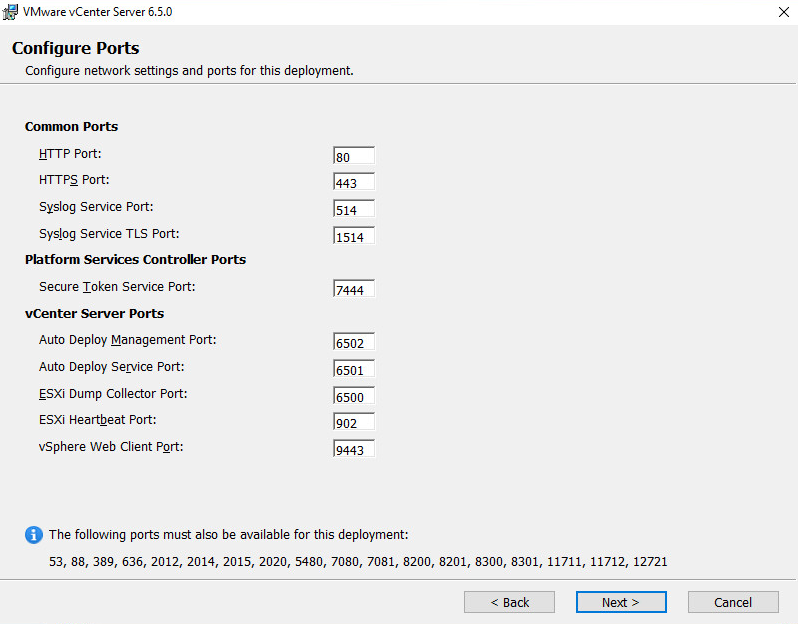
Select the directory to install vCenter services and click Next.

Tick or untick the VMware Customer Experience Improvement Program as appropriate and click Next.

Check the configuration on the review page and click Install to begin the installation process.

Once the installation has completed click Finish.

Post-Installation
Connect to the vCenter post install using the IP or FQDN of the vCenter. Access vSphere by clicking either the vSphere Web Client (Flash) or the vSphere Client (HTML5). Connect to the vSphere Web Client to manage your system, the thick client (Windows) is no longer supported.
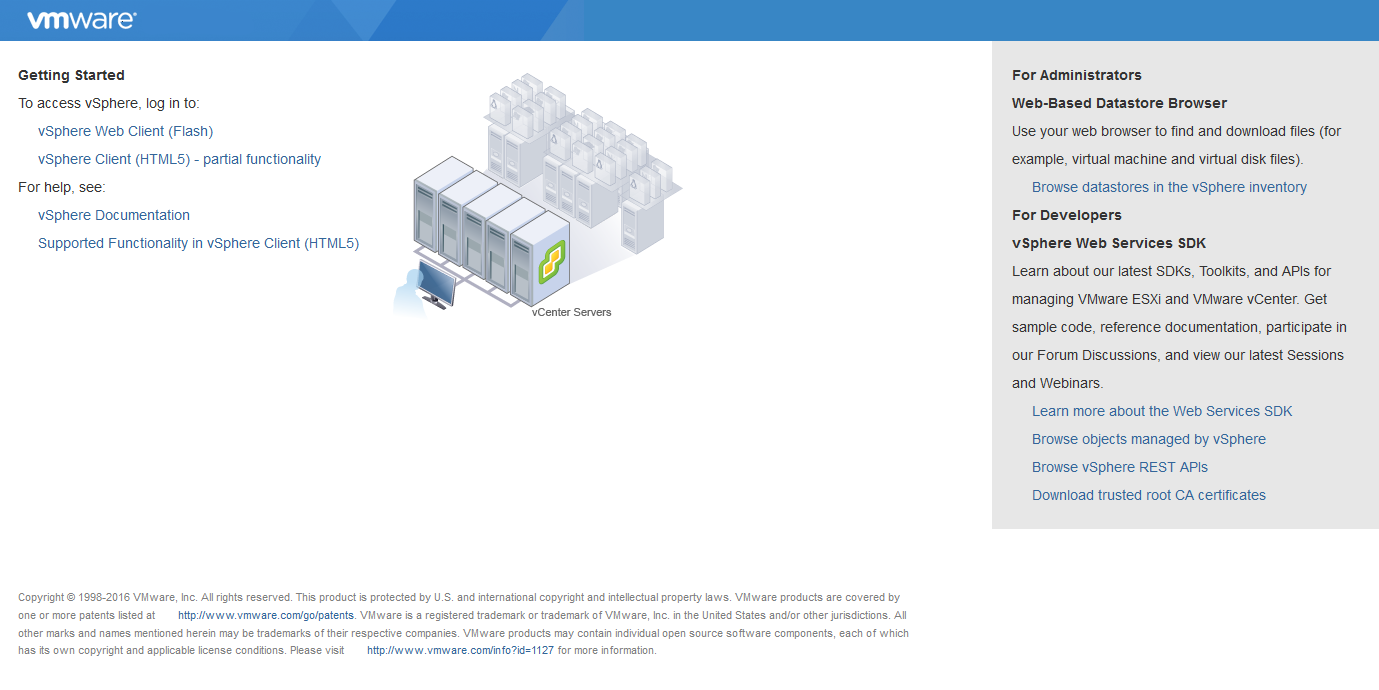
Log in to the vSphere Web Client using the SSO administrator login. Verify the installed version is correct under the Summary tab when selecting the vCenter, you can also go to Help > About.
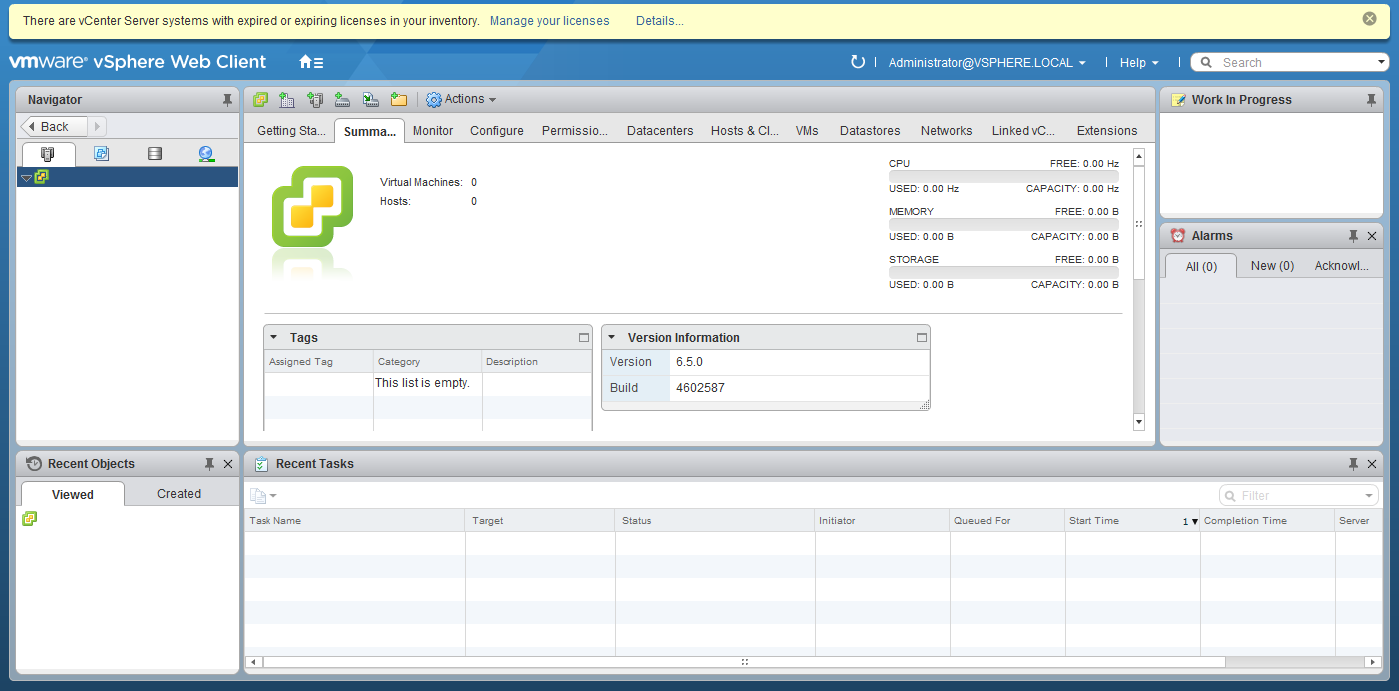
You must apply a new vCenter license key within 60 days. From the Hosts and Clusters view select the vCenter Server. Click Actions and Assign License. Select a license or use the green plus button to add a new license and click Ok.
You can obtain a 60 day trial license for vCenter Server here. If you have purchased vCenter Server then log into your licensing portal here. If the license key does not appear then check with your VMware account manager.

If you have an Active Directory domain then vCenter can use this as a source for permissions and sign on credentials. First join the vCenter to the domain; from the home page click System Configuration, Nodes, and select the vCenter server. In the Active Directory section of the Manage tab click Join, input your AD details and click Ok. Reboot the appliance either right clicking the vCenter server under Nodes and selecting Reboot.
When the vCenter server comes back online we can add AD as an identity source; from the home page click Administration, under Single Sign-On select Configuration. Ensure the Identity Sources tab is open and click the green plus symbol to add a source. Fill in the Active Directory details for your domain and click Ok.

You can now add permissions to vCenter objects such as datacentres, clusters, folders, individual virtual machines, etc. for Active Directory users and groups by selecting the object and clicking Permissions under the Manage tab. To learn more about how vSphere permissions work review the vSphere permissions documentation section.


Great article there. Many thanks.
LikeLike
how about the if upgrading from 5 to 6.5? how to backup vcenter ?
LikeLike
Assuming you are referencing Windows vCenter… full backup of the server, full backup of the database, I walk through the upgrade process in this post > https://esxsi.com/windows-vcenter65-upgrade/
LikeLike
My Vcenter is a physical server, how do I go by backing up the databases, i’ve been David has the SQL express installed but there’s no management studio
LikeLike
Ok, for embedded SQL you will need to install Management Studio to backup the database – see https://kb.vmware.com/kb/2012138. You will still need a backup of the Windows server using whatever backup software you have in your environment. Also have a look at VCSA migration, all data is migrated from the Windows 5.5 vCenter to VCSA 6.5.
LikeLike
I just read that it’s better to upgrade to 6.0 first it looks like there are some important VMware products that are not yet compatible with 6.5.
LikeLike
As with all GA releases other products need time to catch up with version compatibility. The links in this article, particularly the one in red, should be reviewed before upgrading to 6.5. There is a 5.5 to 6.0 upgrade guide on this site too which may be of use.
LikeLike
I have the VCenter 5.5 appliance running as a VM and I’d like to move away from that and onto a stand-alone server for it. The appliance I downloaded from VMWare is not Windows based.
Can I just install 6.5 on Windows Server 2016 and replace the vm… kind of start from scratch and not migrate anything? I only have 3 hosts and about 30 vms.
LikeLike
Hi Bryan. Sure, you can disconnect and remove your hosts from the existing vCenter Server and then add them in to a new vCenter running on Windows 2016. You will obviously need to reconfigure clusters, permissions, all those kind of settings, and you will lose historical performance data. It’s worth mentioning however that the appliance is now the preferred deployment type, there are a lot of improvements in 6.5.
LikeLike
Hi, thanks for this article as it is very useful. I just have a question with regards to upgrading to 6.5. If my organization decides to do the upgrade using a new vCenter server running Windows, how is the existing backups be like when we finally move the hosts and vms to the new vcenter server? do we need to recreate the virtual machine backups or the existing ones will still work?
LikeLike
Hi, depends entirely on how your backup solution works. If you have something like Veeam which hooks into the vCenter then you should just be able to re-add the vCenter and reconfigure the jobs. If you have an OS agent based solution which is unaware of vCenter then it shouldn’t require any additional changes. But again, completely depends on the backup solution, and remember to check the version you are running is compatible with vSphere 6.5.
LikeLike
Yes, we have Veeam for our onsite backup while iland for the offsite one. Thanks, almost forgot to check the compatibility of 6.5 to those backup solution. Thanks for the reminder. Your site is a big help!
LikeLike
Hi, my configuration is, one esxi host 6.5, one host with 5.5(soon to be upgraded to 6.5), 1 vm windows server 2012 r2 with vcenter server installed, host has ip1, vcenter server has ip2.
Now the problem is when i connect to vsphere web client i get stuck with loading…
Any hints
LikeLike
I’m up against a failed upgrade of vCenter 5.5 Windows and wanted to know if I can bounce a few things off you? I’m getting so many errors and VMware TS is no hep which is surprising.
So… I’m spinning my wheels trying to get around failed attempts at upgrading vCenter version 5.5 to 6.5. The current environment has been upgraded from ver 4.0 to 5.5 and is running windows. I’m getting so many errors and VMware TS is no help which is surprising but true.
I’m thinking of starting a new environment of 6.5 (appliance) brand new install and just unsure of the pitfalls and trouble areas and I’ve determined a few things over searching but not everything I feel. I’m uncertain to just jump in and begin. I realize most importantly they can’t run in linked mode since versions are different.
Can I run both vCenter instances simultaneously?
is there any conflicts or trouble areas to consider?
I’ll have different names of the servers but only 1 SAN which hosts all the datastores
Can both instances access the storage w/out issue?
I just don’t want to cause un needed outage since production environment.
LikeLike
Hi John. You can deploy a new appliance, obviously it will require a different name and IP address, remove the hosts from the old vCenter and add them to the new one. Everything will need reconfiguring, clusters, permissions, resource groups etc. Whether this is feasible depends on the size of your environment. You will lose historical performance data (there may be a way to export and import, I haven’t looked). The hosts can only be connected to one vCenter and the datastore mapping is done at host level so the single SAN won’t be a problem.
LikeLike
Hello I’m doing the installation of vcenter 6.5 and at the time of selecting the dsn it appears blank even after configuring ODBC.
LikeLike
Hi, it needs to be 64-bit DSN and you need to be logged in as the account that created it. Not sure why else it wouldn’t show, have you verified the DSN is able to connect?
LikeLike
I’ve a quick question. In your article you have mentioned that vCenter for an x-large environment can support upto 35,000 total registered Virtual Machines.
We are in process of building an environment that has about 120,000 Virtual machines. Please suggest how can we accomplish the same?
LikeLike
Hello ,
I deployed with Vmware 6.5 vcenter server, ESXi 6.5 and Windows AD machines as well as per your guidance. But I am getting serious error when I relog on to web client 6.5. Errror comes as mentioned below:
503 vcenter server web client unavailable
LikeLike
Apologies for the delayed response. Did the web client stop working or did it not work from the start? When I have had this error in the past it only required a restart of the vSphere web client service to resolve.
LikeLike
in our infra we are using Horizon 6.0.1,ESXi 5.5 U2 and Vcenter 5.5.Can we create new infra like ESXi 6.5,vcenter 6.5 and horizon 7.2? create pool from same image(which is running for horizon 6).
LikeLike
Totally new to VMWare here. Does step 1 (mount the ISO) assume that there has already been a Windows server installed, and the ISO has been copied to it? Or is this run somewhere else?
LikeLike